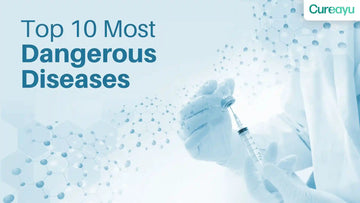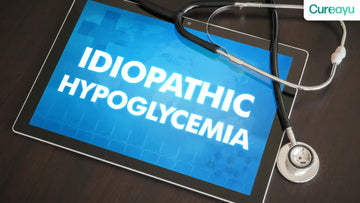In an age where medical advancement is at its peak, it’s easy to forget that lurking in the shadows are diseases that can have devastating consequences. While some of these diseases have become less mysterious thanks to research and development, they remain dangerous and, in some cases, deadly. Understanding these diseases, their symptoms, and their impacts is essential for awareness and prevention. Here, we delve into the top 10 most dangerous diseases that continue to pose significant health risks around the globe.
In this blog, we discuss diseases that affect various parts of the body, ranging from the respiratory tract to the brain and hydration levels. Awareness and understanding of these diseases are the first steps in prevention and control. Read on to learn about tracheal diseases, Alzheimer's, dehydration, and more.
Also Read: 10 Top Cooling Herbs in Ayurveda: Beat the Heat Naturally
1. Tracheal Diseases
Tracheal Cancer
Tracheal cancer, although rare, is a malignancy that occurs in the windpipe or trachea. This tube connects the throat to the lungs and is crucial for breathing. Tracheal tumors can be squamous cell carcinomas or adenoid cystic carcinomas. Symptoms often include a persistent cough, difficulty breathing, and sometimes coughing up blood. Given its vital location, tracheal cancer can quickly lead to life-threatening airway obstruction.
Tracheal Stenosis
Tracheal stenosis is another critical condition involving the narrowing of the trachea due to inflammation, trauma, or congenital factors. This narrowing can severely impact breathing and lead to chronic respiratory symptoms. It’s often caused by prolonged intubation or tracheostomy but can also result from infections or autoimmune diseases. Treatments usually involve surgical intervention to widen the trachea or remove obstructive tissues.
2. Alzheimer’s Disease
Alzheimer's disease is a progressive neurological disorder that leads to memory loss, cognitive decline, and personality changes. It primarily affects older adults, and its symptoms can progress from mild forgetfulness to severe brain impairment, making everyday tasks impossible. The exact cause is unknown, but it's linked to the accumulation of amyloid plaques and tau tangles in the brain.
The impact of Alzheimer's disease extends beyond the individual, placing immense emotional and financial strain on families and caregivers. There is currently no cure, but treatments focusing on symptom management and improving quality of life for sufferers are available. Research is ongoing to better understand the disease and develop more effective treatments and potential cures.
Also Read: Top 10 Frequently Asked Questions About Ayurveda
3. Dehydration
Dehydration occurs when the body loses more fluids than it takes in, disrupting its ability to perform normal functions. This condition ranges from mild to severe and can be caused by inadequate fluid intake, excessive sweating, diarrhea, or vomiting. Symptoms include extreme thirst, dark urine, dizziness, and confusion. In severe cases, dehydration can cause kidney failure, seizures, and even death.
It's particularly dangerous for infants, young children, and the elderly. Preventing dehydration involves regular fluid intake, especially in hot climates or during vigorous exercise. Oral rehydration solutions can treat mild cases, but severe dehydration typically requires immediate medical intervention with intravenous fluids.
4. Cardiovascular Diseases
Coronary Artery Disease (CAD)
Coronary artery disease is the leading cause of death worldwide. It occurs due to the buildup of plaque in the coronary arteries, which narrows them and reduces blood flow to the heart. This can lead to chest pain (angina), heart attacks, and heart failure. Risk factors include high cholesterol, smoking, diabetes, and a sedentary lifestyle.
Hypertensive Heart Disease
Hypertensive heart disease is the result of high blood pressure putting excessive strain on the heart. Over time, this can lead to thickening of the heart muscle, heart failure, or other complications. Blood pressure management through lifestyle changes and medications is crucial in preventing this condition.
5. Chronic Obstructive Pulmonary Disease (COPD)
COPD is a chronic inflammatory lung disease that obstructs airflow from the lungs. It's primarily caused by long-term exposure to irritants, most notably cigarette smoke. Symptoms include breathing difficulty, chronic cough, and mucus production. Over time, COPD limits the ability to perform everyday activities and can lead to severe respiratory infections and heart problems.
Treatment focuses on relieving symptoms and minimizing further damage. This includes quitting smoking, using bronchodilators, and engaging in pulmonary rehabilitation. While COPD cannot be cured, early intervention can improve quality of life and slow its progression.
Also Read: Top 10 Ayurvedic Companies in India: A Journey Through Herbal Excellence
6. Diabetes Mellitus
Diabetes mellitus involves the body's inability to regulate blood sugar levels. Type 1 diabetes is an autoimmune condition resulting in the destruction of insulin-producing cells, while Type 2 diabetes is often linked to obesity and lifestyle factors. Symptoms include frequent urination, extreme thirst, and fatigue.
Poorly managed diabetes can lead to serious complications like heart disease, kidney failure, and neuropathy. Management involves monitoring blood sugar levels, adhering to a healthy diet, and using medications or insulin therapy. Education and regular check-ups are crucial for preventing complications and maintaining overall health.
7. Malaria
Malaria is a life-threatening disease caused by parasites transmitted through the bites of infected Anopheles mosquitoes. It predominates in tropical and subtropical regions. Symptoms manifest as fever, chills, and flu-like illness, progressing to severe complications such as anemia, respiratory distress, and organ failure.
Prevention strategies include using insecticide-treated bed nets, indoor spraying, and anti-malarial drugs. Prompt diagnosis and treatment are vital to saving lives. Despite efforts to curb the disease, malaria remains a significant health challenge in many parts of the world.
8. Tuberculosis (TB)
Tuberculosis is a bacterial infection caused by Mycobacterium tuberculosis, primarily affecting the lungs but potentially impacting other body parts. Because it spreads through airborne particles, close contact in crowded environments increases transmission risk. Symptoms include a persistent cough, weight loss, night sweats, and fever.
Multidrug-Resistant TB
The emergence of multidrug-resistant TB (MDR-TB) poses significant treatment challenges. MDR-TB occurs when the infection doesn’t respond to standard TB medications. Treatment is longer and more complex, often involving second-line drugs with more side effects. Battling TB requires a combination of vaccination, early diagnosis, and adherence to treatment regimens.
9. HIV/AIDS
Human Immunodeficiency Virus (HIV) attacks the immune system, gradually destroying the body's ability to fight infections and certain cancers. Acquired Immunodeficiency Syndrome (AIDS) is the most severe phase of HIV infection. Without treatment, the immune system becomes severely compromised, leading to opportunistic infections and cancers.
Although there is no cure, antiretroviral therapy (ART) can control the virus, enabling individuals to live longer, healthier lives. Education, prevention strategies, and regular testing are vital in reducing new HIV infections and improving access to treatment.
Also Read: Power of High Carbs Foods: Top 10 Options to Fuel Your Body and Boost Energy
10. Ebola Virus Disease
Ebola is a rare but deadly virus causing severe viral hemorrhagic fever. It spreads through direct contact with blood or bodily fluids of infected individuals or animals. Symptoms start with fever, fatigue, and muscle pain, rapidly progressing to vomiting, diarrhea, and internal and external bleeding.
Outbreaks are devastating due to high mortality rates, rapid transmission, and societal disruption. Containment measures include quarantine, safe burial practices, and wearing protective gear. Vaccines and experimental treatments are pivotal in combating this fatal disease, alongside robust healthcare responses during outbreaks.
Conclusion
While these diseases pose significant health threats, advancements in medical research and technology offer hope for better management, treatment, and potential cures. Prevention through education, early detection, and adherence to treatment protocols remain critical in reducing the impact of these life-threatening diseases. Stay informed, stay healthy!











